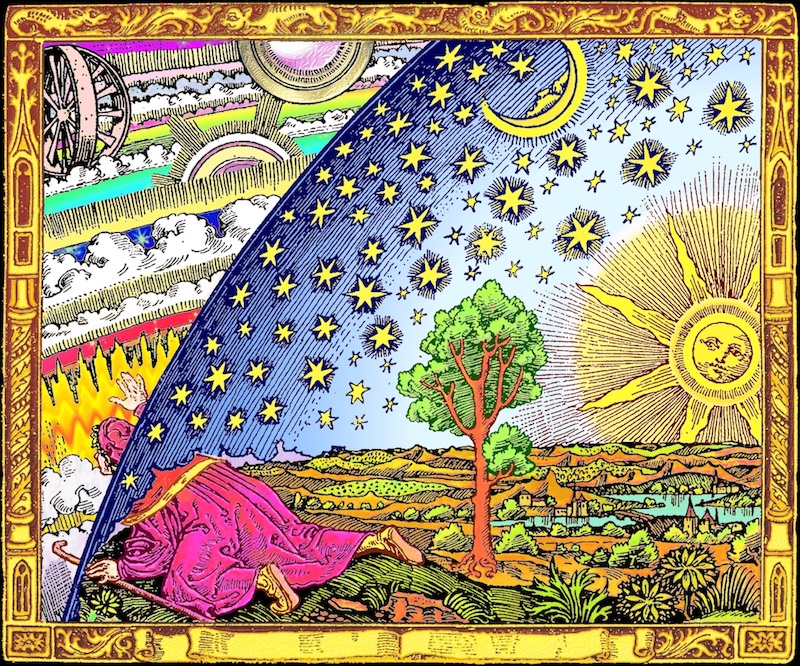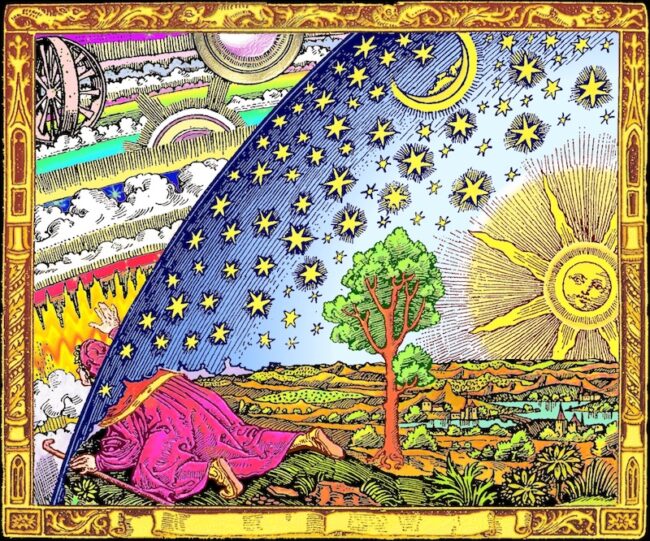
Today as you wake and look out, you might indeed conclude that the landscape you see is exactly the same as yesterday. It is not. You have woken up in a new world, an alien landscape. This is a place that was once peopled by tens of millions who previously identified with organised religion. Something has radically altered how they think. Once, if asked, they would indeed have assured you of their adherence to a specific religious denomination, but no longer. Now they give a very different answer. Instead they will proudly tell you they are a “None”, or “Nothing in particular”.
This has unfolded over several decades and so we might not have appreciated how radical a change it has been. But step back to take a longer view and it becomes clear that something has messed with how we think about many things.
There are numbers to back this up.
Let’s take a look so that you can appreciate just how dramatic it all truly is.
The Pew Deep Dive
On Jan 24, Pew Research did a deep dive into their latest Religious Landscape survey data and have surfaced clutching the latest statistics.
Titled “Religious ‘Nones’ in America: Who They Are and What They Believe”, you can find their analysis via this link here.
- You can also find the full 95 page PDF here. … er yes … 95 pages. They really love their statistics.
When did they collect their latest data sample?
That happened July/Aug 2023 It involved roughly about 12,000 participants that take part in their ongoing American Trends Panel. That tends to cover a wide range of topics, and so this latest release of their analysis from that focuses on “Nones”. If curious, the Pew report goes into it all in great detail and explains (From page 89 onwards) what their methodology is, and how they quality check the data.
My intent here is not to replay it all, but instead to flag up some surprising insights.
Surprise 1 of 3: The number of Nones
In 2007 the percentage of Nones was 16%.
This latest data reveals that it is now 28%. That’s a vast increase in just 16 years …
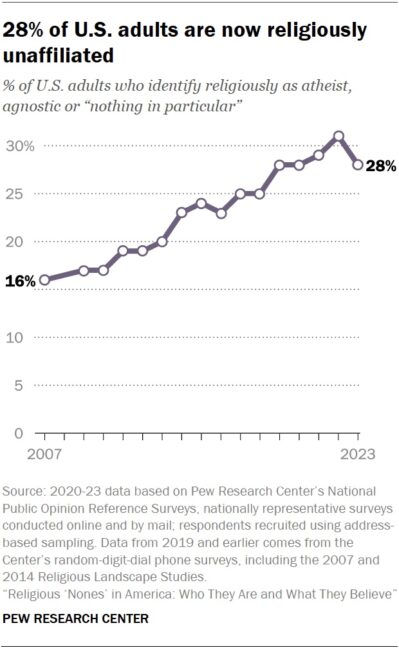
Wait, hold on a second. According to the above not too long ago it was 31% and so it has now dropped back down to 28%.
To address that, let me give you a slightly bigger picture, one that looks further back in time. What the following reveals is just how dramatic the rise of the nones really is. It has gone from under 5%in the early 70’s to what it is now …
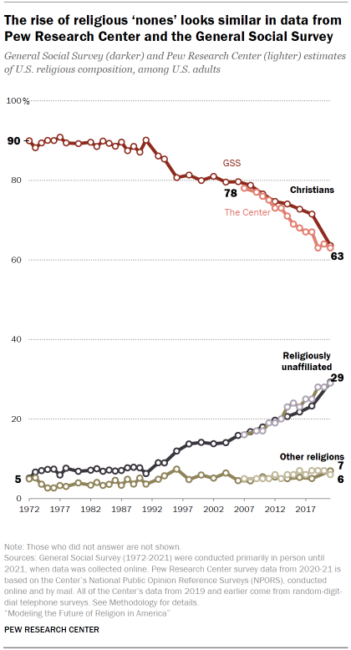
What immediately becomes clear is that starting in the early 90s the upwards trend of “Nones” commenced and has continued upwards ever since then
Drill into it and you can see there have been dips, but also that over the longer term the upward trend has continued.
As for the latest dip, well you know how this works. It will be something like this …
- The Religious: The Nones are in decline now and we are winning at last
- The Non-Religious: It’s just a blip
In the context of the bigger picture, the dramatic social transformation remains – 28% of people identify as nones.
So have we reached a plateau, or are the nones now in decline, or will it once again register an untick next time?
We can of course speculate, but until we get more data we will not know.
Anyway, the key takeaway is this. 28% of the population, roughly 94 million humans, have taken a hard pass on organised religion in the US.
Politicians who are exclusively pandering to the religious really are going to have to rethink their strategies.
Surprise 2 of 3 – Many Nones are still Religious
Yes there are those that identify as both “Atheist” and also “Agnostic”, but most Nones simply refuse all labels and say “Nothing in Particular” …
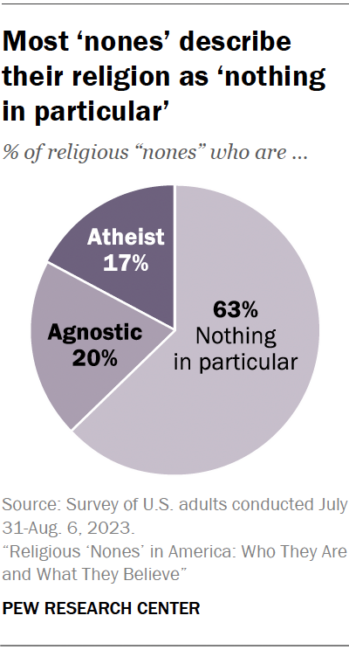
But what does that actually mean?
What it appears to mean for many is that while they do still believe that there is a God, or a higher power, they totally reject organised religion and also mostly reject the concept of a God as described by the bible.
When they were asked about this, 56% opted for belief in a vague “Higher Power” …
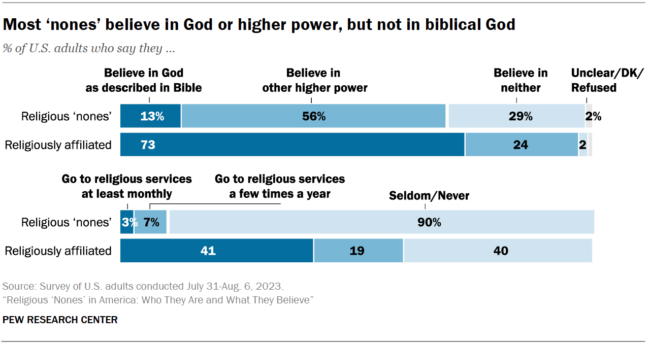
Almost half of them also identify as spiritual …
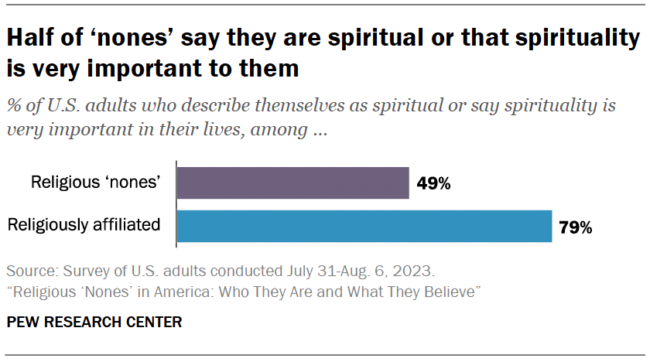
Well yes, “Spiritual” is one of those vague fuzzy words that can mean rather a lot of different things.
Think of it this way – it’s a hard pass for organised religion, but for many it is not an outright rejection of the supernatural. Clearly rather a lot of people no longer wish to be told what to believe or how to practise what they believe, but instead have opted for a far more individualistic approach to life and what it means for them.
Surprise 3 of 3 – Why Do Nones now Exist in such large numbers now?
Within their survey Pew asked them directly – why are you not religious?
The answers fall into categories you might perhaps guess at, so that’s not the surprise here.
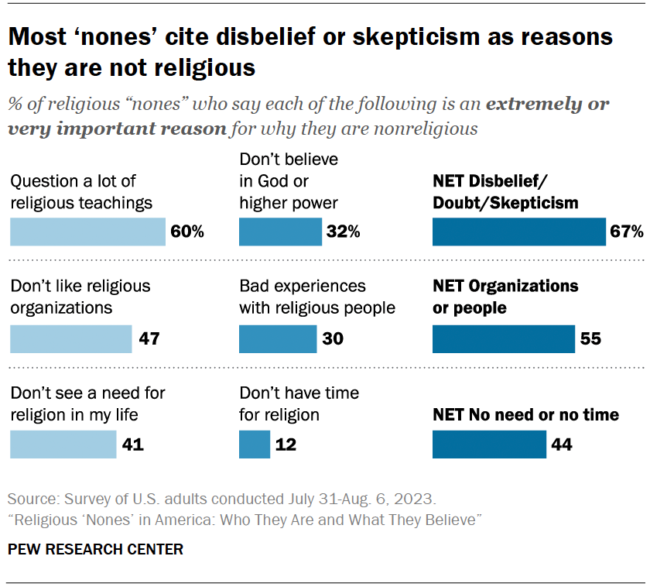
What is interesting to ponder over is to wonder why people started asking themselves such questions, what inspired the uptick in doubt, why did so many, and remember we are talking about very large numbers of people, discover that they were unhappy with what was going on inside their churches?
A clue perhaps rests in when the uptick in numbers began…
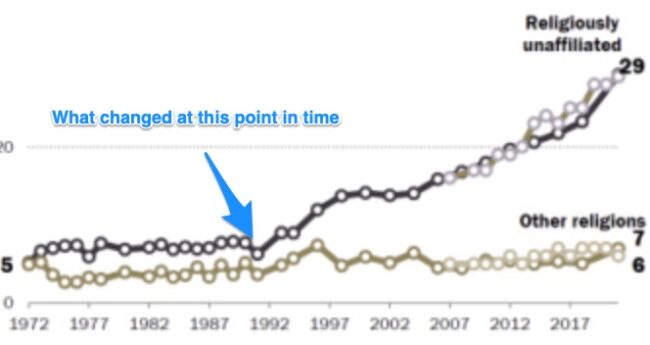
There are of course various things that correlate with the early 90s.
The one with the greatest disruptive impact, is one that dramatically increased the flow of information.
The Internet.
We have seen it before.
When something new happens that greatly increases the flow of available information, it disrupts a great deal and that includes how we think and what we believe. Access to that new flow of information ends up transforming us and our culture. The best most well-known example is of course the arrival of the printing press. Suddenly new ideas could be rapidly replicated on a huge scale and spread far and wide. It changed everything. It can be seriously argued that it led to a great deal of disruption and change – the Reformation, the Renaissance got a huge boost, the Enlightenment, the Scientific Revolution, and much much more.
So what happened in the early 90s?
The internet, while it had been bubbling away for a bit, really took off about then and rapidly spread a vast new flow of information.
It impacted, not just the US, but humanity on a global scale. Some of what came from it is good, and some … well, not so much, because it led to a vast increase in not just information, but also misinformation and disinformation.
So why are there nones?
My argument is that it is the inevitable result from exposure to rather a lot of new information. It changed, not just the world around us, but also disrupted what we believe and how we believe it.
One last thought – the boy that drives the plow
Back in the early 1520s, the religious reformer Willian Tyndale, was confronted by a priest who was rather pissed about Tyndale’s desire to translate the Bible into English for all to read. The stance that the priest took is that it was up to the Pope to tell people what to believe and that reading the bible was not something ordinary people should be doing.
“I defy the Pope and all his laws. If God spare my life ere many years, I will cause the boy that drives the plow to know more of the scriptures than you!”
He kept his promise by not only translating it, but by flooding the land with printed copies of his translation.
For the first time ever, people could read it for themselves, not by learning Latin, but by reading it in the language they spoke.
It enabled each individual to make up their own minds about what it said and so they would no longer be shackled to what the church dictated. This transformed how people thought about belief by breaking the monopoly religion had and changed that information dictatorship into an information democracy.
Further Reading
As mentioned above, the Pew report titled “Religious ‘Nones’ in America: Who They Are and What They Believe“ is well worth a read and contains lots of interesting details.
- You can also find the full 95 page PDF here.
